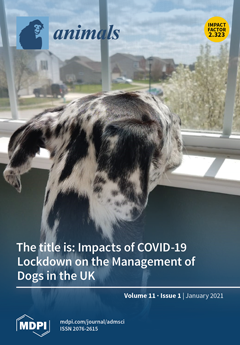This research was conducted to investigate if the administration of the probiotic
Lactobacillus fermentum could influence body weight, intestinal morphometry and the cecal cytokine response in
Campylobacter jejuni-infected chickens. Seventy-two 1-day old COBB 500 male chicks were allocated randomly into four experimental
[...] Read more.
This research was conducted to investigate if the administration of the probiotic
Lactobacillus fermentum could influence body weight, intestinal morphometry and the cecal cytokine response in
Campylobacter jejuni-infected chickens. Seventy-two 1-day old COBB 500 male chicks were allocated randomly into four experimental groups. (I) Control group (C), in which chicks were left untreated. (II) LB group, treated with
L. fermentum. (III) Cj group, infected with
C. jejuni and (IV) coexposure group in which both bacteria were administered. Body weight was registered and then all birds were slaughtered; samples from the small intestine and caecum were collected at 4- and 7-days post infection. The experiment lasted eleven days. Villi height and crypt depth ratios of the duodenum, jejunum and ileum were evaluated using appropriate software, while reverse transcription quantitative PCR (RT-qPCR) was utilized for assessing transcript levels of key cecal inflammatory cytokines (IL-1β, IL-18, IL-17, IL-15, IL13 and IL-4).
Campylobacter-infected birds showed lower body weight values than those supplemented with the probiotic; these birds, in turn, proved to be heavier than those reared under control conditions.
L. fermentum administration improved morphometrical parameters of the duodenum, jejunum and ileum; in general, villi were larger and crypts deeper than those identified in control conditions. Moreover, the negative effects elicited by
C. jejuni were not observed in chickens exposed to the probiotic. Significant differences were also determined with regards to transcript abundance of all evaluated cytokines in the caecum.
C. jejuni induced a downregulation of the studied interleukins; however, such a response was heightened by administration of
L. fermentum, with an increase rate of transcription that promoted a more effective response to a
C. jejuni infection. The effects of experimental treatments proved to vary between sampling points. Conclusively, these results demonstrate that
L. fermentum lessens the negative effects elicited by
C. jejuni on body weight by alleviating the impact on intestinal morphometry and cecal cytokine response, which ultimately improve chicken growth performance.
Full article






